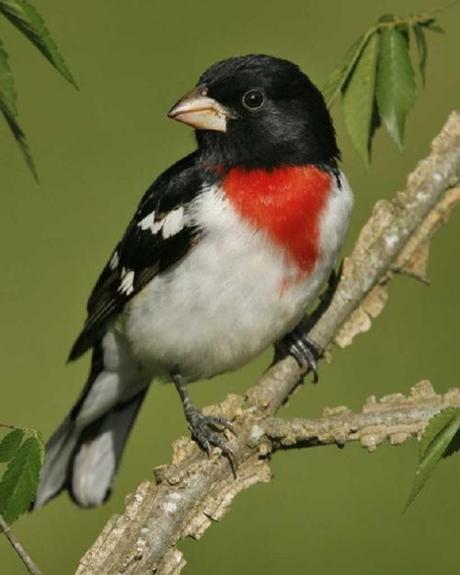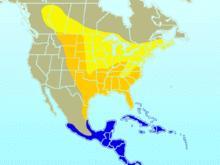Pheucticus ludovicianus
 The rose-breasted grosbeak (Pheucticus ludovicianus) is a large insect-eating songbird in the cardinal family. It breeds in cool-temperate North America, migrating to tropical America in winter. The rose-breasted grosbeak occurs as a very rare vagrant in western Europe.
The rose-breasted grosbeak (Pheucticus ludovicianus) is a large insect-eating songbird in the cardinal family. It breeds in cool-temperate North America, migrating to tropical America in winter. The rose-breasted grosbeak occurs as a very rare vagrant in western Europe.
Adult birds are 7.1–8.7 in long, span 11–13 in across the wings and weigh 1.2–2.3 oz, with an average of 1.6 oz. The adult male in breeding plumage has a black head, wings, back and tail, and a bright rose-red patch on its breast.

Rose-breasted grosbeak’s range in North America
The rose-breasted grosbeak’s breeding habitat is open deciduous woods across most of Canada and the northeastern USA. To winter, they migrate south through east of the Rocky Mountains, from central-southern Mexico through Central America and the Caribbean to Peru and Venezuela. The southern limit of its wintering range is not well known.
The rose-breasted grosbeak builds a twig nest in a tree or large shrub. It forages in shrubs or trees for insects, seeds and berries, also catching insects in flight and occasionally eating nectar. It usually keeps to the treetops, and only rarely can be seen on the ground.
In general, though it requires mature woodland to breed and is occasionally caught as a cage bird, the rose-breasted grosbeak is not at all rare, and not considered a threatened species by the IUCN. Its maximum lifespan in the wild is 7.3 years.
H/t FOTM’s swampygirl
~Eowyn

